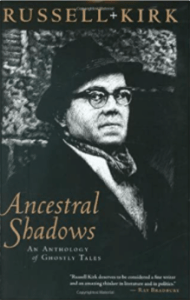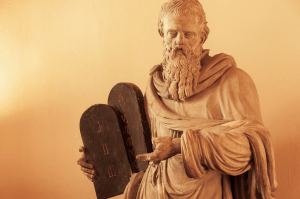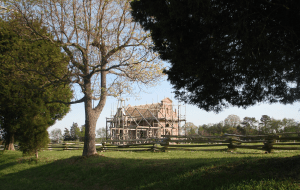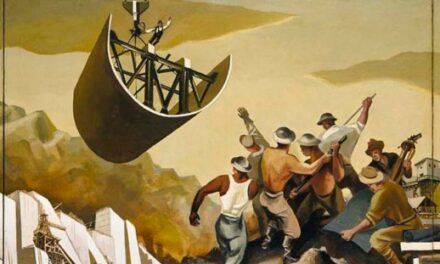We support our Publishers and Content Creators. You can view this story on their website by CLICKING HERE.
During my years of teaching, I have frequently admonished students with this deeply held conviction. If you can find a cultural critic or essayist that you enjoy, and he or she also happens to write fiction—read it.
While Russell Kirk (1918-94) is best known as one of the founding fathers of post-World War II conservatism, a cultural critic, historian and political thinker, he has also been praised by the likes of Ray Bradbury, T.S. Eliot, and Madeleine L’Engle as a teller of ghostly tales.
Ancestral Shadows: An Anthology of Ghostly Tales is a collection of nineteen of Kirk’s best “ghostly” tales from periodicals and anthologies published throughout his life. The average literary treat is approximately seventeen pages in length. A few of these tales delightfully exceed forty. These stories are a real intellectual pleasure by an accomplished scholar and man of letters. The intellectual virtues wonderfully blended with form and content are manifested within this fiction, which conveys the essence of the permanent things by means of the moral imagination.
If this is the reader’s first encounter with the thought of Russell Kirk, great assistance comes by way of the helpful introduction by Vigen Guroian. Guroian contends that “for a comprehensive understanding of Kirk’s conservative vision, a familiarity with his fiction is necessary, for it is here that Kirk’s rich imaginative mind vividly casts the drama of the soul’s struggle with good and evil in relation to a transcendent realm of meaning and purpose.”
 After the introductory essay by Guroian, the reader may actually benefit by reading the concluding essay by Kirk. “A Cautionary Note on the Ghostly Tale” is an insightful addition in which Kirk muses over why he writes such stories. Kirk observes, “All important literature has some ethical end…and the tale of the preternatural — as written by George Macdonald, C. S. Lewis, Charles Williams, and other masters — can be an instrument for the recovery of moral order.”
After the introductory essay by Guroian, the reader may actually benefit by reading the concluding essay by Kirk. “A Cautionary Note on the Ghostly Tale” is an insightful addition in which Kirk muses over why he writes such stories. Kirk observes, “All important literature has some ethical end…and the tale of the preternatural — as written by George Macdonald, C. S. Lewis, Charles Williams, and other masters — can be an instrument for the recovery of moral order.”
Describing his own stories, Kirk notes, “The tales in this volume have retributive ghosts, malign magicians, blind angels, beneficent phantoms, conjuring witches, demonic possession, creatures of the twilight, divided selves. I present them to you unabashed. They may impart some arcane truths about good and evil; as Chesterton put it, all life is an allegory, we can understand it only in parable.”
Reminiscent of medieval morality plays where the drama is set on a cosmic stage, particular characters struggle with particular vices and virtues in places and time with eternal implications. While Kirk has favorably been compared to Edith Wharton, Ambrose Bierce, and Edgar Allen Poe, one can also see affinities to the style and atmosphere of Charles Williams and Flannery O’Connor.
In comparable fashion to Williams, Kirk often blurs the artificial lines we construct between this realm and the ultimately authentic world beyond this one. It is with a profound sense of mystery that Kirk’s stories unfold. Similar to MacDonald, Lewis, Williams, and O’Connor, Kirk’s fiction could easily be characterized as sacramental. In other words, there are everyday realities that serve as signs pointing to a transcendent reality often ignored or unnoticed. This reality can and does break into our experiences and move us through marginalized moments toward that which is definitive.
Kirk was a fabulous prose stylist, as anyone who has read his non-fiction could attest. His skill and imagination are demonstrated in these stories. The plots and settings are imaginative and varied while peopled with believable characters struggling with redemption.
Just as it is stated of Uncle Isaiah that he “left his brand on people”, it could be said of other characters that inhabit the literary and moral universe of Russell Kirk. Characters such as Raymond Thomas Montrose, Isaiah Kinnaird, Gerald Ogham, Cribben, Sarah Corr, Yolande, Frank Sarsfield, and Fork Causland tend to stay with the reader.
Encountering various compelling characters in Kirk’s fiction moves the reader to introspection. “A sargeant’s son, I was born in Spanish Town, Jamaica, and I am shiny black: nobody excels me in negritude. The barmaids of Pentecost Road say I have a ‘cute British accent.’ I believe in the Father, the Son, and the Holy Ghost; the resurrection of the dead; and the life everlasting. I am celibate, not quite forty years of age, and since my ordination chaste of body. I have survived Hawkhill a whole year.” The various encounters, trials, temptations, failures, and a graced victory, parallel those of the readers’ who may be open to the workings of the divine.
The reader also inhabits the terrain of places such as Low Watford, Balgrummo Lodging, Parish of Hawkhill, Anthonyville, and Tomarack House which, in turn, become part of the reader’s internal landscape.
Among the many enjoyable tales in this book, there are a few that are truly outstanding. A Long, Long Trail A-Winding and Watchers at the Straight Gate are two tales featuring the most unique central character, Frank Sarsfield. His life is multi-layered and emotionally moving. In The Invasion of the Church of the Holy Ghost, (closely resembling the spiritual atmosphere of certain Flannery O’Connor short stories), ghosts are agents of Satan. While this evil reality is not as powerful as God’s“ghosts”, it can still work the master’s dark will. The Surly Sullen Bell is an effectively heartbreaking story of unfulfilled love unified within a disturbing plot. Balgrummo’s Hell follows a traditional plot of the end to which greed leads.
In a cautionary tale for bibliophiles, What Shadows We Pursue describes how an excessive fixation on books (like anything else) can bring deceit and death. In Saviourgate, a distracted man moves beyond the normal temporal and spatial bounds to find genuine courage.
These stories are all placed within a moral universe where actions, words, and events have weighty import. Russell Kirk was an orthodox Catholic believer and affirmed belief in real good and diabolical evil, the presence of sin, a need for repentance, salvation, and judgment in both the here-and-now and the age to come.
The secular and sacred, holy and profane, temporal and eternal bleed into one another in Kirk’s ghost stories in an approach parallel to the novels of Charles Williams. Take as one example this description, “Shoddy little theaters for X-rated films (their marquees promising more than they can deliver, in competition with the living flesh next door or down the road); ‘adult’ bookshops for retarded adolescents and middle-aged illiterates; scantly stocked tiny ‘notion’ shops that are fronts for narcotic-peddling—these are the thriving enterprises of Pentecost Road, in this year of our Lord. The hideousness of it hurts as much as the depravity.”
Kirk writes in a captivating, entertaining, and engaging prose giving incarnation to his deeply held convictions. Signals of transcendence constantly break through even as the decline of mundane surrounding is described, “Fashionable suburbs, the automobile, and industrialization had turned the North End into a boneyard of defaced and degraded old houses.” Or in another scene, “There were more than two thousand people here in town and roundabout, a few years after the General built Tamarack House! But first the lumber industry gave out, and then the mines were exhausted, and the prison-break in 1915 scared many away forever. There were no passenger trains now, and they say the railway line will be pulled out altogether when the new freeway—they have just begun building to the east—is ready for traffic. But we still have the maples and the tamaracks, and there are ever so many raccoons and the opossums and squirrels for you to watch—and a lynx, I think, and an otter or two, and many deer.” This scene is evocative of author Wendell Berry with the key difference that it is set within a backdrop of a purgatorial environment.
Characterization is achieved through the normal means, but the language used by Kirk’s theological heritage is utilized, “‘I look upon you, sir,’ said Isaiah Kinnaird, ‘an an interesting phenomenon of social disintegration, a representative specimen of these depraved days.”
Kirk likens the ghostly tale to the “parable and fable” and comments that these stories “can be a means of expressing truths enchantingly.” So what is it that makes these “ghosts stories” so ghostly? In Kirk’s own words, describing the “ghosts stories” of others, “The better uncanny stories are underlain by a healthy concept of the character of evil.” These are not mere bump-in-the-night, goose bump, chills producing stories; rather these are tales that have the capacity to move the soul toward refection. Kirk does indeed accomplish the task of unblocking the “keyhole” and allows us to peer through to the other side.
This essay was first published here in February 2012. It originally appeared on Musings of a Christian Humanist.
The Imaginative Conservative applies the principle of appreciation to the discussion of culture and politics—we approach dialogue with magnanimity rather than with mere civility. Will you help us remain a refreshing oasis in the increasingly contentious arena of modern discourse? Please consider donating now.
The featured image is courtesy of Pixabay. It has been brightened for clarity.

 Conservative
Conservative  Search
Search Trending
Trending Current News
Current News 






